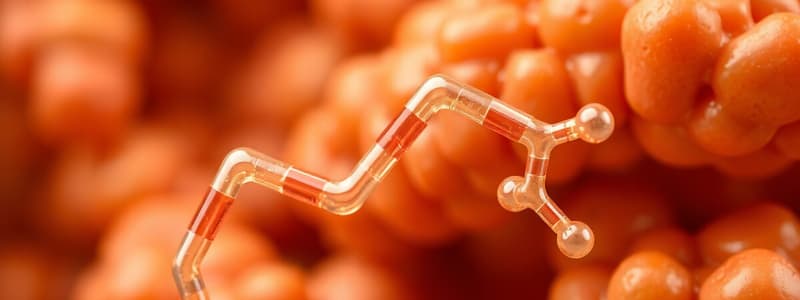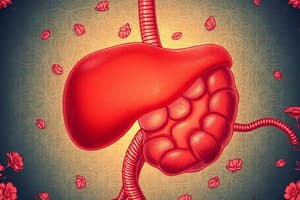Podcast
Questions and Answers
During cholesterol synthesis, which of the following conversions is directly targeted by statin medications to lower cholesterol levels?
During cholesterol synthesis, which of the following conversions is directly targeted by statin medications to lower cholesterol levels?
- Acetyl-CoA to HMG-CoA
- Squalene to Cholesterol
- Mevalonate to Squalene
- HMG-CoA to Mevalonate (correct)
If the enterohepatic circulation of bile salts is disrupted, what direct effect would this have on cholesterol levels in the body?
If the enterohepatic circulation of bile salts is disrupted, what direct effect would this have on cholesterol levels in the body?
- Decreased cholesterol absorption and increased excretion (correct)
- Increased cholesterol synthesis in the liver
- Reduced delivery of cholesterol to peripheral tissues by HDL
- Enhanced transport of cholesterol via LDL
The liver synthesizes a significant amount of cholesterol daily. How does the body primarily regulate this synthesis to maintain cholesterol homeostasis?
The liver synthesizes a significant amount of cholesterol daily. How does the body primarily regulate this synthesis to maintain cholesterol homeostasis?
- Increased bile acid reabsorption in the jejunum
- Negative feedback of cholesterol on HMG-CoA reductase (correct)
- Positive feedback of LDL on HMG-CoA reductase
- Hormonal activation of squalene synthase
Which lipoprotein is responsible for transporting cholesterol from peripheral tissues back to the liver, aiding in cholesterol excretion?
Which lipoprotein is responsible for transporting cholesterol from peripheral tissues back to the liver, aiding in cholesterol excretion?
According to the information, the 'diet-heart hypothesis' posits a relationship between dietary saturated fat and cardiovascular disease. What is a limitation of this hypothesis as presented?
According to the information, the 'diet-heart hypothesis' posits a relationship between dietary saturated fat and cardiovascular disease. What is a limitation of this hypothesis as presented?
Flashcards
Acetyl-CoA
Acetyl-CoA
The main precursor molecule in cholesterol synthesis, derived from glucose, fatty acids, and amino acids.
HMG-CoA Reductase
HMG-CoA Reductase
An enzyme that catalyzes a key step in cholesterol synthesis, converting HMG-CoA to mevalonate.
Enterohepatic Circulation
Enterohepatic Circulation
The recycling process of bile salts from the intestine back to the liver.
LDL (Low-Density Lipoprotein)
LDL (Low-Density Lipoprotein)
Signup and view all the flashcards
Cholesterolemia
Cholesterolemia
Signup and view all the flashcards
Study Notes
- Precursors: Glucose, Fatty Acids (FA), Amino Acids (AA)
- Cholesterol synthesis pathway involves multiple steps:
- Step 1: Acetyl-CoA to HMG-CoA
- Step 2: HMG-CoA to Mevalonate to Squalene
- Step 3: Squalene to Cholesterol
- HMG-CoA reductase is a rate-limiting step in cholesterol synthesis.
- Cholesterol exerts negative feedback on HMG-CoA reductase.
- Statins: blocks HMG-CoA reductase.
- Liver produces 800 to 1500 mg of cholesterol every day.
- Liver needs bile, cholesterol makes bile.
- Gonads make cholesterol for hormones.
Enterohepatic Circulation
- Enterohepatic circulation is the process by which bile salts are reabsorbed in the gut.
- Bile is formed from the liver.
- 50% Cholesterol reabsorption.
- Free cholesterol and bile salts are in bile.
- Excretion is 50%.
- 97% bile acid reabsorption in the jejunum/ileum.
- Free cholesterol and bile salts are reabsorbed or excreted.
Cholesterol Transport
- LDL, HDL, VLDL transports cholesterol and drops it off at the liver.
Diet-Heart Hypothesis
- Saturated fats links to cholesterolemia and cardiovascular disease.
- Saturated fat found in poultry and dairy can lead to cholesterol clogging arteries.
- Correlated saturated fat to cardiovascular disease.
- Cherry-picked argument.
Studying That Suits You
Use AI to generate personalized quizzes and flashcards to suit your learning preferences.
Related Documents
Description
An overview of cholesterol synthesis, its transport, and the enterohepatic circulation. Key topics include the cholesterol synthesis pathway, the role of HMG-CoA reductase and statins, and the process of bile salt reabsorption in the gut. Also covers cholesterol transport via LDL, HDL, and VLDL.




